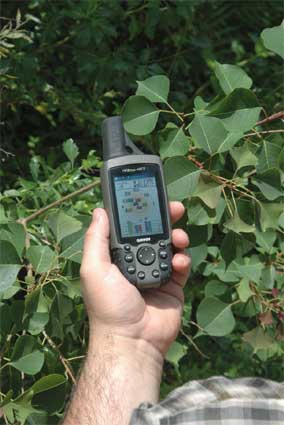Early Detection and Rapid Response (EDRR)Even the best prevention efforts cannot stop all invasive species. Early detection, rapid assessment and rapid response is a critical second defense against the establishment of invasive populations. EDRR increases the likelihood that localized invasive populations will be found, contained, and eradicated before they become widely established. EDRR can slow range expansion, and avoid the need for costly long-term control efforts. Effective EDRR depends upon the timely ability to answer critical questions such as1:
Successful Early Detection and Rapid Response Programs include2:
|  Taking GPS coordinates of Chinese tallow tree infestation Photo by: David Moorhead, UGA |
Early Detection and Rapid Response Networks
More Information
- A National Early Detection and Rapid Response System for Invasive Plants in the United States
- General Guidelines for the Establishment & Evaluation of Invasive Species Early Detection & Rapid Response Systems
- Executive Order 13112 of February 3, 1999 - Invasive Species
- National Early Warning and Rapid Response System for Invasive Plants
- Early Detection of Invasive Plant Species Handbook
- The Early Warning System for Forest Health Threats in the United States
- Early Detection of Invasive Plant Species in the San Francisco Bay Area Network
- Neighborhood Watch - Early Detection and Rapid Response to Biological Invasion along U.S Trade Pathways
- Denying Entry: Opportunities to Build Capacity to Prevent the Introduction of Invasive Species and Improve Biosecurity at U.S. Ports
- National Framework for Early Detection, Rapid Assessment, and Rapid Response to Invasive Species
1 National Invasive Species Council. 2008. 2008-2012 National Invasive Species Management Plan. 35 pp. http://www.invasivespeciesinfo.gov/council/actionc.shtml
2 National Invasive Species Council. (2003) General Guidelines for the Establishment and Evaluation of Invasive Species Early Detection and Rapid Response Systems. Published by the National Biological Information Infrastructure (NBII) Invasive Species Information Node. http://invasivespecies.nbii.gov/documents/inv_NISCEDRRGuidelineCommunication.pdf
Partners
